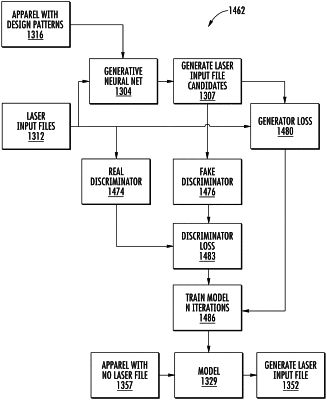| CPC D06B 11/0096 (2013.01) [A41B 1/08 (2013.01); A41D 1/02 (2013.01); A41D 1/04 (2013.01); A41D 1/089 (2018.01); A41D 1/14 (2013.01); A41D 3/00 (2013.01); A41D 27/00 (2013.01); A41D 27/08 (2013.01); A41H 43/00 (2013.01); B23K 26/36 (2013.01); D03D 1/00 (2013.01); D03D 15/43 (2021.01); D06C 23/02 (2013.01); D06M 10/00 (2013.01); D06M 10/005 (2013.01); D06P 5/15 (2013.01); D06P 5/2011 (2013.01); G06F 18/214 (2023.01); G06N 3/002 (2013.01); G06N 3/02 (2013.01); G06N 3/045 (2023.01); G06N 3/088 (2013.01); A41B 2500/20 (2013.01); A41D 1/06 (2013.01); A41D 2500/20 (2013.01); D06P 1/228 (2013.01); D10B 2501/04 (2013.01)] | 19 Claims |

|
1. A method comprising:
providing an assembled garment made from fabric panels of a woven first material comprising a warp comprising indigo ring-dyed cotton yarn, wherein the fabric panels are sewn together using thread;
providing a laser input file that is representative of a finishing pattern from an existing garment made from a second material, wherein the finishing pattern on the existing garment was not created by a laser, and the laser input file was obtained by
providing sample laser input files and images of sample garments with lased finishing patterns resulting from the sample laser input files to a generative adversarial network, wherein the sample laser input files comprise real laser input files for the generative adversarial network,
using a generative neural net of the generative adversarial network, generating fake laser input files for the images of sample garments with lased finishing patterns,
determining a generator loss based on the fake laser input files and the real laser input files,
inputting the real laser input files to a real discriminator of the generative adversarial network,
inputting the real laser input files and the fake laser input files to a fake discriminator of the generative adversarial network,
determining a discriminator loss based on outputs of the real discriminator and fake discriminator, and
based on outputs of the generator loss and discriminator loss, iteratively training a model to obtain final model, wherein the final model generates the laser input file for an image of the existing garment with the finishing pattern; and
using a laser to create a lased finishing pattern on an outer surface of the assembled garment based on the laser input file, wherein based on the laser input file, the laser removes selected amounts of material from the surface of the first material at different pixel locations of the assembled garment,
for lighter pixel locations of the lased finishing pattern, a greater amount of the indigo ring-dyed cotton yarn is removed, while for darker pixel locations of the lased finishing pattern, a lesser amount of the indigo ring-dyed cotton yarn is removed, and
the lased finishing pattern created is able to extend across portions of the assembled garment where two or more fabric panels are joined together by threads at least by exposing these portions to the laser.
|